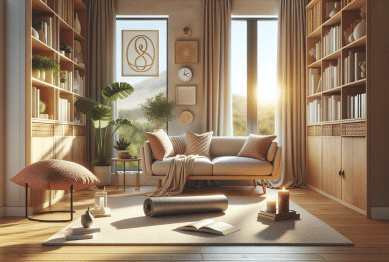Is your space filled with more things than memories? This exploration into minimalist living reveals why simplicity is capturing attention and how it influences well-being, home design, daily habits, and even entertainment preferences.
Understanding Minimalist Living and Its Growing Appeal
Minimalist living is much more than owning fewer possessions. At its core, it’s about intentional choices—every object, activity, or relationship should serve a purpose or bring joy. As people seek ways to declutter both their physical and mental landscapes, minimalism stands out as a path toward greater life satisfaction. Its roots can be traced to philosophical traditions like Zen Buddhism, but its impact has truly gained traction recently thanks to social media, documentaries, and shifting lifestyle priorities.
What’s shaping this trend? It’s not simply an aesthetic decision, although streamlined décor features strongly on platforms like Instagram and Pinterest. Minimalism resonates because it promises freedom: freedom from debt, from household chaos, and from the pressure to keep up with ever-changing trends. Statistics from multiple consumer studies reveal a steady rise in interest for sustainable, clutter-free environments and digital detox routines, with younger generations particularly drawn to purposeful living (Source: https://www.pewresearch.org/fact-tank/2022/01/25/how-pinterest-and-jobs-help-pew-research-center-recruits-participants/).
Minimalist living can look different for each person. For some, it means downsizing to a smaller home and for others, being mindful about lifestyle habits. There’s no single right way to do it. The movement has been popularized by influencers, documentaries, and best-selling books, all highlighting benefits like improved mental clarity, reduced cleaning time, and increased ability to focus—appealing traits in a world crowded with distractions.
The Link Between Home Design and Simplicity
One area where minimalism makes a strong visual impression is home design. Interior designers encourage neutral palettes, clean lines, and open spaces that foster both calm and creativity. Instead of purchasing décor simply to fill walls or shelves, minimalists focus on what’s functional and meaningful. The effect? Rooms that invite relaxation and mental clarity. Design experts even suggest that a lack of visual clutter supports restful sleep and lowers overall stress. Multiple home improvement platforms have documented this shift, with minimalist style now ranking among the most coveted online searches (Source: https://www.american.edu/soc/cdi/interior-design-trends.cfm).
Adopting a minimalist approach doesn’t require expensive renovations. It can begin with small steps: donating unused items, choosing multi-functional furniture, or letting natural light fill your space. Simple changes—like reducing knickknacks and streamlining furniture—create a sense of order. Many people report this not only makes cleaning easier but also helps them feel “lighter,” emotionally and mentally. Scientific reviews have drawn links between cluttered spaces and increased anxiety, while minimalist settings are associated with elevated mood and productivity.
There’s also evidence that minimalist interiors support sustainable living. A focus on quality over quantity pushes consumers to buy fewer, longer-lasting items. This reduces waste—a top concern among eco-conscious households. Less consumption translates directly to fewer deliveries and packaging materials, as noted by environmental agency reports, making this lifestyle choice impactful on a global scale (Source: https://www.epa.gov/smm/sustainable-management-materials-non-hazardous-materials-and-waste-management-hierarchy).
Daily Habits and the Minimalist Mindset
Minimalism doesn’t stop at rearranging living rooms. It extends to decision-making and routines. By prioritizing needs over wants, individuals discover more efficient ways to approach daily tasks. This often means embracing quality rather than quantity—choosing a smaller wardrobe of versatile pieces, for example, or meal-prepping with wholesome, simple ingredients. These habits cut down on unnecessary expenditure and create time for leisure or self-care. Studies conducted by wellness advocacy groups suggest a direct correlation between minimalism-inspired routines and lower reported stress levels (Source: https://www.apa.org/topics/stress/healthy-living).
Another way the minimalist mindset shows up: mindfulness around technology. Many adopt digital minimalism, which means setting boundaries on time spent online and being selective about digital subscriptions. Reducing screen time and information overload helps fight mental fatigue. Happiness surveys reveal minimalist digital habits are tied to higher personal satisfaction and more quality interactions—offline and on social media alike.
By focusing only on commitments that align with their values, minimalists often find themselves with more bandwidth to cultivate personal relationships and hobbies. Instead of filling their schedule, they intentionally leave space for relaxation and creativity. This can result in a greater sense of balance, improved mental health, and a deeper appreciation for everyday moments. Many people discover that saying no to some things opens up opportunities they never expected.
Entertainment Choices in a Minimal World
Minimalist values influence how people approach entertainment as well. Rather than subscribing to countless streaming services or buying stacks of games, some opt for curated experiences. Whether it’s one well-reviewed series at a time or board game nights with friends, the goal is quality over abundance. Entertainment professionals have observed that pared-down options can increase satisfaction and prevent “choice overload,” a phenomenon where too many options reduce overall enjoyment (Source: https://www.scientificamerican.com/article/why-choice-is-unhealthy/).
For many, minimalist entertainment means reconnecting with hobbies that spark creativity and mindfulness. Activities like reading, painting, yoga, or walking outdoors fit into this lifestyle by encouraging active participation rather than passive consumption. Some report greater fulfillment from these pursuits, and research in creative health supports this, showing benefits for both mood and resilience.
Thoughtful entertainment decisions often lead to rediscovered social connections. Hosting dinners, volunteering, or engaging in local cultural events replace routines of endless scrolling or binge-watching. Communities around the world have seen a revival in group activities, suggesting minimalism is as much about “doing more with less” as it is about reducing screen dependence (Source: https://www.npr.org/sections/health-shots/2019/05/28/726892255/for-better-health-fewer-screens-and-more-face-time).
Wellness, Sustainability, and Community Impact
Minimalist living comes with a surprising benefit: a stronger sense of well-being. Multiple mental health organizations report that a simplified environment can soothe anxiety, boost mood, and increase resilience against life’s inevitable stressors. People with less clutter in their homes consistently report improved sleep and concentration. This highlights the connection between external space and internal peace (Source: https://www.ncbi.nlm.nih.gov/pmc/articles/PMC8221344/).
Sustainability is a natural outgrowth of the minimalist mindset. By consuming less, citizens help lower their carbon footprint. This means fewer items headed to landfills, less demand on natural resources, and support for ethical brands. Community organizations are promoting minimalist principles as part of local environmental initiatives. Their aim is to educate on how even small changes—reusable shopping bags, conscious fashion choices—can have ripple effects nationwide. Such strategies are often highlighted in neighborhood workshops and online awareness campaigns.
Minimalism encourages a broader appreciation for community and shared experiences. Instead of focusing on personal acquisition, many minimalists look outward—donating goods, supporting local projects, or volunteering time. This collective approach strengthens neighborhood bonds and supports social responsibility. Reflection and gratitude are central here: by living with less, people often gain much more in terms of connection, purpose, and fulfillment.
Tips to Start Minimalist Living at Any Stage
Curious about how to get started? Transitioning to a minimalist lifestyle doesn’t require sweeping changes overnight. Many suggest beginning with a single area—perhaps a closet, desk, or digital photo library. Sorting items by whether they “spark joy,” a phrase made famous by Marie Kondo, can help clarify what remains and what goes. Even one decluttered space can motivate further transformation.
Simple, consistent routines are most effective. Try limiting new purchases by implementing a “one in, one out” rule, where every new item replaces an existing one. Setting weekly intentions—such as a device-free evening or a homemade meal—makes it easier to form sustainable habits. Incremental steps prevent overwhelm and allow space to adapt your new lifestyle in a way that feels authentic.
Finally, focus on self-awareness and flexibility. Minimalism is not about denial but about crafting a life aligned with your values. Listen to your own needs. Adjust your approach as circumstances change. What matters most is discovering what brings real meaning and letting go of whatever distracts from it. The minimalist path is personal, ongoing, and accessible to anyone willing to begin.
References
1. Pew Research Center. (2022). How Pinterest is used for trend tracking. Retrieved from https://www.pewresearch.org/fact-tank/2022/01/25/how-pinterest-and-jobs-help-pew-research-center-recruits-participants/
2. American University. (n.d.). Interior Design Trends. Retrieved from https://www.american.edu/soc/cdi/interior-design-trends.cfm
3. U.S. Environmental Protection Agency. (2022). Waste Management Hierarchy. Retrieved from https://www.epa.gov/smm/sustainable-management-materials-non-hazardous-materials-and-waste-management-hierarchy
4. American Psychological Association. (2020). Managing daily stress. Retrieved from https://www.apa.org/topics/stress/healthy-living
5. Scientific American. (2021). Why choice is (sometimes) unhealthy. Retrieved from https://www.scientificamerican.com/article/why-choice-is-unhealthy/
6. National Institutes of Health. (2021). Effects of clutter on well-being. Retrieved from https://www.ncbi.nlm.nih.gov/pmc/articles/PMC8221344/









